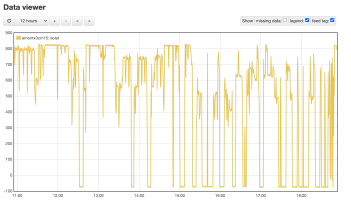Our solar hot water is electrically heated, it was a £100 box that you sit on the existing immersion heater circuit, it uses a Triac and current clamp sensor to vary the power going to the heating element to match whatever excess solar electricity you are generating. I worked out with the current price per KWh of gas and the maximum amount of heat that could be stored in our tank (approx 3.5 kwh from luke warm) and the limited amount of excess power we generate the payback time was about 3 years. If I had used an electrician to install the device, picked a more expensive model or needed to alter the existing hot water system then the expense wouldn't have justified the savings.Solar hot water to me (at the moment) just seems conflicted and unfortunate, but it is what it is for the system and societary rational that exists at the moment, although I could contine for a few pages on this... every positive difference counts.
Directly heated solar hot water (e.g. evacuated tube panels) don't really make financial sense for retrofit residential use, they are more efficent and you can fit a larger tank to act as a bigger energy store but the equipment and installation costs are too expensive to ever justify via cost savings. I think even if you were electrically heating your hot water (rather than gas boiler) you would struggle to break even over a sensible time frame. In fact it would probably be cheaper to fit more solar PV panels and divert the extra electricity to whichever house demand is most appropriate. Thereby consolidating on one energy transmission and storage medium rather than several (i.e. just electricity rather than heated hot water and natural gas via a boiler). Most of the UK Govt clean energy transition plan is about moving to a single source of energy transmission and then trying to green that, so get people off of natural gas boilers onto heat pumps, off of diesel into electric cars, then you can use multiple methods to clean up electricity generation and storage. Everything else like E10 petrol, Hydrogen in the gas network or lorries is really just a stopgap fix.
I'm currently debating on getting another 1-2 units vs the GTIL 2kW unit and driftying back towards another 1-2 units. I tend to switch off the units (via zero output - 2W) rather then keep them "online" and output active power, which I'm thinking (hope) should minimise the loading on the internal caps and extend life significantly. This is where I think many rather than the few could have an advantage for a multitude of reasons.
It's difficult to predict how something electronic will fail, it is not always governed by runtime hours or load and depends on the design. About the only thing that is certain is that if it is completely 'off' then it's not degrading as quickly, of course you have no way of knowing if on/off cycling is a contributor to longevity (e.g. CFL bulbs are sensitive to on/off cycling and short run times, but last ages if they are on for long periods of time. LED bulbs are limited by overall runtime hours - and heat). So probably best to just not worry about it!! One thing is certain, the more units you have operating in parallel the more likely you will experience a failure, but the less inconvinient it will be, and if 4 cheap units are the same price as 1 expensive unit then replacement costs would be lower, or at least spread out.
I would say this is the primary difference between buying a cheap device off of aliexpress and buying an expensive SMA or ABB inverter from a manufacturer approved local reseller. You are getting a better engineered device, but you are also getting installation support, spares and repairs service and a warranty. If you buy a soyosource inverter you are taking on these risks for the benefit of paying less and potentially having to buy twice... oh and the lack of regulatory approvals. Thats not to say its a bad design, it just lacks the value add of a local distributor and design (other brands are probably still made in China) .What I still don't about these units is the manufacturer or anyone representing them does not respond to "any" wetern consumer feedback (requests or otherwise). This is what I think really undermines any "real legitimacy" wihtin the market and greater confidence of consumers. I guess any manufuacturer can easily choose to destroy or miss out on part of their own market, although Homer Simpson would be a far better CEO in these instances. (maufcacturer : "do something !!!""). Western market is looking for a "solution", why not help ??? (FFS "leak" the full protocol !!!!!)
For me personally if I had to buy a higher quality European developed inverter and ancillaries then the cost benefit case would be out the window and I wouldn't be using a storage battery for peak shaving and demand shifting. In return I have to take the risk it might not perform as well as a Tesla Powerwall, might give me more headaches consume more of my time and might just break at any moment... or it might work faultlessly for ever and ever.




